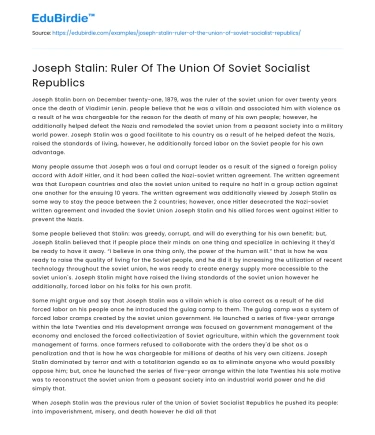Introduction
Joseph Stalin, a pivotal figure in the history of the 20th century, was the leader of the Union of Soviet Socialist Republics (USSR) from the mid-1920s until his death in 1953. His rule was marked by a rapid transformation of the Soviet Union from a peasant society into a major world power, albeit through methods that were often brutal and repressive. Stalin's policies and leadership style had profound effects on both the USSR and the wider world, leaving a legacy that is still debated by historians today. As a central figure in the establishment and consolidation of Soviet power, Stalin's reign was characterized by widespread industrialization, collectivization of agriculture, and a pervasive cult of personality. This essay examines Stalin's influence on the Soviet Union's political, economic, and social spheres while addressing the counter-arguments that surround his controversial leadership.
Political Repression and Cult of Personality
Stalin's political strategies were marked by significant repression and the establishment of a cult of personality. Under his leadership, the Communist Party transformed into an instrument of control, centralizing power in Stalin's hands. The Great Purge of the 1930s exemplifies this, wherein millions of people, including party officials, military leaders, and ordinary citizens, were executed or sent to labor camps. Robert Conquest, a notable historian, estimates that around 700,000 people were executed during the peak years of the purges from 1937 to 1938 (Conquest, 1990). This period of terror was justified as a means to eliminate "enemies of the state," yet it also served to consolidate Stalin's absolute authority.
Save your time!
We can take care of your essay
- Proper editing and formatting
- Free revision, title page, and bibliography
- Flexible prices and money-back guarantee
Stalin's cult of personality was another cornerstone of his rule. Propaganda depicted him as an infallible leader, often portraying him as a father figure and a genius on par with Lenin. This image was carefully crafted through media, education, and art, ensuring that Stalin's presence permeated every aspect of Soviet life. The philosopher Hannah Arendt discusses the impact of totalitarianism in such regimes, highlighting how the manipulation of truth and reality serves to maintain control over the population (Arendt, 1951). Despite these oppressive measures, some argue that Stalin's leadership was necessary to maintain the ideological purity of the Communist Party and to protect the Soviet state from internal and external threats.
Economic Transformation and Industrialization
Stalin's economic policies were aimed at transforming the Soviet Union into an industrial powerhouse. The implementation of the Five-Year Plans, beginning in 1928, marked a significant shift towards a centrally planned economy. The primary focus was on heavy industry, with targets set for steel, coal, and machinery production. According to economic historian Alec Nove, by the end of the second Five-Year Plan in 1937, Soviet industrial output had significantly increased, transforming the USSR into the world's second-largest industrial economy (Nove, 1992).
However, this rapid industrialization came at a great cost. The forced collectivization of agriculture led to widespread famine, most notoriously the Holodomor in Ukraine, where millions perished. Critics argue that Stalin's policies prioritized industrial output over human welfare, leading to immense suffering and loss of life. Yet, proponents contend that industrialization was crucial for the Soviet Union's survival, particularly in light of the looming threat of Nazi Germany. The Soviet capacity to produce military equipment played a critical role in the USSR's eventual victory in World War II, suggesting that Stalin's economic policies, despite their brutality, were instrumental in the country's wartime success.
Social Policies and Legacy
Stalin's social policies were heavily influenced by his desire to create a unified Soviet identity. Education was centralized, with curricula emphasizing Marxist-Leninist ideology and Russian language and culture. This was part of a broader Russification policy aimed at fostering a cohesive national identity despite the USSR's diverse ethnic composition. Social historian Sheila Fitzpatrick notes that these policies were effective in creating a generation of Soviet citizens who identified strongly with the state (Fitzpatrick, 2000).
Nevertheless, Stalin's legacy is deeply contentious. While some view him as a strong leader who modernized the Soviet Union and played a crucial role in defeating fascism, others condemn the human cost of his policies, including the purges, famines, and forced labor camps. The historian Stephen Kotkin argues that understanding Stalin's impact requires acknowledging both the achievements and the atrocities of his regime (Kotkin, 2014). His legacy continues to influence post-Soviet states, where debates over his role in history often reflect broader discussions about national identity and historical memory.
Conclusion
Joseph Stalin's rule over the Soviet Union was a period of profound transformation and controversy. His leadership was marked by a combination of ruthless repression and ambitious economic policies that reshaped the Soviet state. While his methods were often brutal, resulting in significant human suffering, the impact of his rule on the Soviet Union's status as a global power cannot be understated. The duality of Stalin's legacy—his achievements in industrialization and military success juxtaposed with the immense human cost—continues to be a subject of intense debate among historians. Ultimately, Stalin's reign exemplifies the complexities of leadership in a totalitarian state, where the pursuit of power and ideology often comes at the expense of human rights and individual freedoms.






 Stuck on your essay?
Stuck on your essay?

